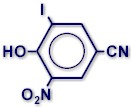Nitroxinil is an antiparasitic active ingredient used in veterinary medicine in livestock against internal parasites (some roundworms and liver flukes). It is not used against agricultural and household pests. It belongs to the chemical class of the halogenated phenols.
Common name: NITROXINIL
Other names: NITROXYNIL
Type: veterinary medecine
Chemical class: halogenated phenol
CHEMICAL STRUCTURE

EFFICACY AGAINST PARASITES
Type of action: Flukicide and nematicide anthelmintic, endoparasiticide
Main veterinary parasites controlled: liver flukes, a few roundworm (nematodes) species
Efficacy against a specific parasite depends on the delivery form and on the dose administered.
Click here for general information on features and characteristics of PARASITICIDES.
DOSING
Click here to view the article in this site with the most common dosing recommendations for nitroxinil used in domestic animals.
SAFETY
Oral LD50, rat, acute*: 170-450 mg/kg (various salts)
Dermal LD50, rat, acute*: not found
* These values refer to the active ingredient. Toxicity has to be determined for each formulation as well. Formulations are usually significantly less toxic than the active ingredients.
MRL (maximum residue limit) established for either beef, mutton pork or chicken meat*:
- CODEX: No
- EU: Yes
- USA: No
- AUS: No
* This information is an indicator of the acceptance of an active ingredient by the most influential regulatory bodies for use on livestock.
Withholding periods for meat, milk, eggs, etc. depend on delivery form, dose and national regulations. Check the product label in your country.
Learn more about nitroxinil safety (poisoning, intoxication, overdose, antidote, symptoms, etc.).
General safety information for antiparasitics is available in specific articles in this site (click to visit):
- General safety of antiparasitics for domestic animals
- General safety of antiparasitics for humans
- General safety of antiparasitics for the environment
|
WARNING It is obvious that veterinary products are not intended for and should never be used on humans!!! |
MARKETING & USAGE
Decade of introduction: 1960
Introduced by: MAY & BAKER (→ RHÔNE-POULENC → SANOFI-AVENTIS - MERIAL)
Some original brands: TRODAX, DOVENIX
Patent: Expired (particular formulations may be still patent-protected)
Use in LIVESTOCK: Yes, scarce, in ruminants
Use in HORSES: NO
Use in DOGS and CATS: No
Main delivery forms:
Use in human medicine: No
Use in public/domestic hygiene: No
Use in agriculture: No
Generics available: Yes, a few
PARASITE RESISTANCE
In livestock: No.
Learn more about parasite resistance and how it develops.
SPECIFIC FEATURES
Nitroxinil is a low spectrum flukicide and nematicide not very much used on cattle, sheep and goats. It is available mostly in the form of injectables, often in combination with ivermectin.
In the EU is the only flukicide with an established MRL for bovine and ovine milk, i.e. it can be used on dairy animals respecting the withholding period established for each particular product.
It is not used in dogs or pets.
Efficacy of nitroxinil
Nitroxinil is highly effective against adult liver flukes (Fasciola hepatica ) and against late immature stages (> 6 weeks) in cattle.
It is also effective against a few gastrointestinal roundworms (e.g. Bunostomum spp, Haemonchus spp, Oesophagostomum spp, and Parafilaria bovicola) as well as against myiases caused by the sheep nasal bot fly (Oestrus ovis).
In contrast with many other anthelmintics (e.g. imidazothiazoles, benzimidazoles, tetrahydropyrimidines), nitroxinil has a residual effect, i.e. it not only kills the parasites present in the host at the time of treatment, but protects against re-infestation for a period of time (up to several weeks) that depends on the dose and the specific parasite.
Nitroxinil is not effective against rumen flukes (Paramphistomum spp), other roundworms such as lungworms (e.g. Dictyocaulus spp) or eyeworms (e.g. Thelazia spp), tapeworms and other external parasites.
Pharmacokinetics of nitroxinil
Injected nitroxinil binds very strongly and almost completely (>97%) to plasma proteins. Concentrations in blood are substantially higher than in the tissues.
Unchanged nitroxinil is excreted through the liver and this is why high concentrations are found in the bile ducts, the preferential sites of adult liver flukes. It is also metabolized in the liver parenchyma to a metabolite that has also flukicidal activity, which explains its efficacy against late immature flukes that migrate through the liver tissues.
Metabolism of nitroxinil is rather slow and occurs mainly in the liver. Excretion through feces and urine is quite slow as well, and takes about 30 days to be completed. Excretion half-life in sheep is about 8 days.
After oral administration, microorganisms in the rumen break it down to ineffective compounds. This is why injectables are preferred over drenches.
Mechanism of action of nitroxinil
Nitroxinil is an uncoupler of the oxidative phosphorylation in the cell mitochondria, which disturbs the production of ATP, the cellular "fuel". This impairs the parasites motility and probably other processes as well.
Click here to view the list of all technical summaries of antiparasitic active ingredients in this site.